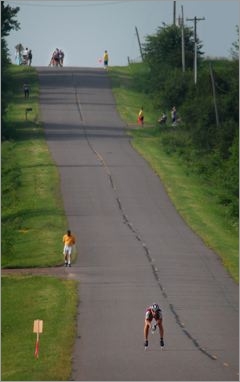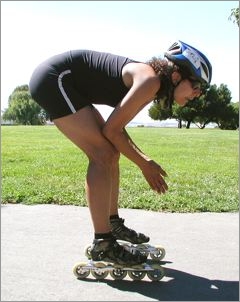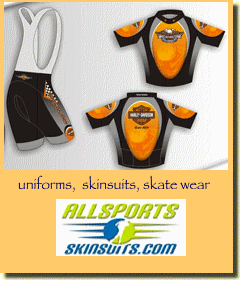Skate skills:
The Ups and Downs of Hills
Part 2:
How to Descend
Skating down hills requires know-how and self control
By Kim Perkins
(posted Tuesday, July 11, 2006)

Hills are one of the thrills of inline skating. ... But to be safe, you've got to know what you are doing.
Photo: Darlene Prois
You know the saying: What goes up must come down. If you don’t know what you're doing, going downhill on skates can feel terrifyingly out of control. But with a little knowledge and practice, it turns into a welcome rest from the climb or an eagerly-anticipated shot of adrenaline.
Leaving downhill racing strategies to the fearless guys and gals in leather, here’s all you need to know for tackling the kinds of hills you'll encounter on race courses and fitness trails.
Most downhill accidents come not from pavement imperfections, traffic, stray dogs, or any of the zillion things we worry about. The number one cause of downhill accidents is panic.
When you get going faster than you’d like, your body has two natural reactions, both of which actually increase the likelihood of an accident. The first reaction is to stand up, which raises your center of gravity and makes you less stable.
The second reaction is to try to brake, which usually requires lifting one foot and dragging your wheels or your heel brake, multiplying the number of things that can go wrong and make you crash.
Usually, all you have to do to make it safely down a hill is assume the position and STAY PUT.

Kim Perkins demonstrates the "long hill" position.
Photo: Inline Planet
How to Assume the Position:
1. Get down
Getting low isn't just about being aerodynamic. Even if you aren’t interested in increasing your speed, being safe still means lowering your center of gravity. To get started with the position, just put your hands on your knees; no need for flat back or super-bent knees unless you want more speed. Stay down for the entire hill, until you are ready to start stroking again on the rollout.
2. Weight on your heels
Keeping your weight to the back lets you blithely bump over pavement imperfections that might otherwise stop you short. It is the single most important rule of descent. Put your weight solidly over your heels at all times, with no weight at all on your toes, to the point where your toes float up and bump the tops of your boots. Check your ankle angle – if it’s close to 90 degrees, your weight is nicely on your heels. If it’s acute, you are leaning forward and your weight is too much on your toes. To correct, either scoot your feet a little forward or sit back as if into a chair. Practice correcting this stance on flat land until you are ready to try it on the hill. As you descend, concentrate on your heels so you don't unconsciously inch forward.
3. Feet shoulder width apart, no more, no less
Putting your feet together may seem more aerodynamic, but it makes you less stable. Keep your feet parallel and your wheels straight up and down.
Defeating speed wobbles
Speed wobbles are a scary feeling like "fishtailing" in your car. You can virtually eliminate them by keeping your weight on your heels, not your toes. Find a small slope and practice correcting it: Put a small bit of weight on your toes, then remove it all by leaning back on your heels.
Getting more speed
Once you are confident with the basic position, get more speed by flattening your back (so your elbows, not your hands, rest on your knees), and bending your knees lower. (See photo above.) When descending in a paceline, many experienced racers use the "long hills" position described below, with only the first person in line bending their knees low.
Long hills
On a long hill, bending your knees to 90 degrees will make your quads cry out in pain before you get to the bottom – not good for an endurance race. For max speed down a long hill (such as the NYC Skate Marathon in Prospect Park), develop a position with your back flat, elbows on knees, your knees bent only very slightly, and your feet scooted well forward relative to your butt, so that your ankles still form 90 degree angles and your weight is firmly on your heels.
Descending in a paceline
With everyone pushing the person in front, the increased mass of a paceline can take you much faster than you could go solo. However, if you aren't at least as low as the person in front of you, the wind will push you back and cause a gap. Transfer your energy to the person in front of you by pushing forward on the small of the back, or if it's a super-fast hill, solidly on the butt with both hands. If you're scared, it's hard not to hang onto their hips for dear life, but you may get your hands slapped. NEVER change leads on a downhill. If you are catching up to a pack, yell “Contact!” before grabbing onto the person in front of you. If you are being caught and don't want them to push you, don't change your body position; instead, aim yourself away from the middle of the road and wave the pack on.
Turning
Races rarely have hard turns at the bottom of hills. If you have to turn left at speed, scissor your left foot forward a bit and lean into the turn from your hip, not your shoulder. Don't put your weight on the foot to the outside of the turn, and don't take either foot off the ground.
Stopping down hills
When going downhill on a bicycle, if you get scared, you can just slam on the brakes. It does not work that way in skating. You cannot slow down easily halfway down a hill, especially once you are scared. Instead, it's a Zen lesson – you are going to have to commit to the hill. You can brake a bit at the top (if you need to) while you are still going slow. Then, when it's time to roll, just get in position and vow to stay there all the way to the bottom.
Beating fear
No matter what level you're skating, a downhill can sometimes make your temperature rise. Here's how to keep your cool:
1. Take it in steps. Go one third of the way up, assume the position, and roll down. Then go half way up. Repeat until you can go the whole way.
2. Wear a GPS. You are not going nearly as fast as you think you are, and the GPS can prove it.
3. When you get really scared, repeat my mantra: Low, heels. Focus on what you need to do to stay safe, not on the zillion imaginary things that "might" happen to make you lose it.
***
Kim Perkins was one of the top women skaters in the United States before retiring from racing last year. She specialized in ultra-distance events, like the Athens to Atlanta Road Skate, which she won in 2002, 2003 and 2004. These days, she coaches privately and is pursuing a graduate degree at San Francisco State University.
- Go to her web site.
The Ups and Downs of Hills
• Go to Part 1: How to climb
Related reading
- Beginner's Guide to Outdoor Racing
- Beginner's Guide to Inline Skating
- Marathon Training and Skating for the Advance Competitor
Disclaimer: Skating down hills can be dangerous. Even if you do everything right, you could fall. Bottom line: Don't skate beyond your ability or comfort level. You could get hurt!








